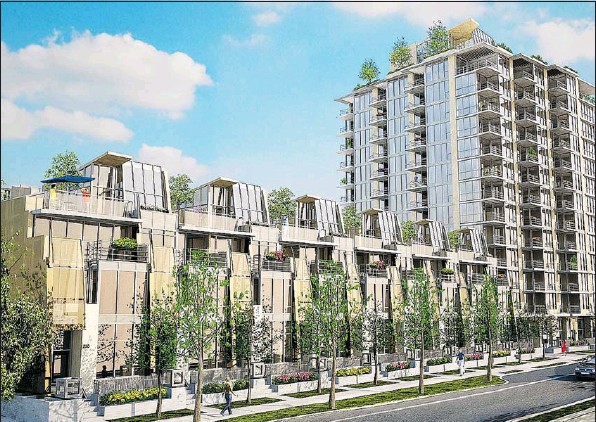Builders and their brokers put a lot of thought into the namesof their buildings
Felicity Stone
Sun

Cressey Development’s James new-home project in False Creek is named after an early Vancouver industrialist, James Doherty.
Few Canadian homes have names. Official, or government, residences like Rideau Hall in Ottawa, are one exception. Multi-residence buildings are another. Some of their names are straightforward: Water’s Edge, Parkview Towers. Others, not so.
On a recent locally produced CBC radio show, a reporter challenged the host to guess which of the following is not the name of a new-home project in the Fraser Valley: Oliva, Green Meadows, Ethical Gardens, Tamarind, Suede and Sahara Living. Green Meadows was the right answer.
People’s names are one source of new-home-project names. The Erickson is named after the late Arthur Erickson, the world-renowned Vancouver architect who designed it. The Beasley honours a retired city planner, Larry Beasley; Alda, Alda Pereira, who designed its interiors; The Rolston, B.C. politician Tilly Rolston and the street, Rolston Crescent, above which the Yaletown development will rise.
But James? Why not William or Jane for the Cressey development in Southeast False Creek? Why James?
James, it turns out, was inspired by James S. Doherty, who owned a company on the property and supplied deck equipment to the Canadian navy and merchant marine. Cameron McNeill of Mac Marketing Solutions explains that all involved in the development wanted to honour the property’s industrial heritage without going too deeply into the history.
Using Doherty’s first name is more personal, in keeping with the project’s boutique nature, he says. Plus: “We wanted something more grand and sophisticated, but not overly marketing-ish.”
Diana McMeekin’s Artemis Marketing Group has helped name scores of Vancouver real estate projects.
Although developments are named to assist marketing and sales campaigns, says McMeekin, it is important that the name have a level of authenticity that can be substantiated.
It could reflect the architecture or general design (Mondrian, Lumiere, Jacobsen, Alda); the location (Arbutus Walk, Bedford Landing, District Crossing, Highland Park); or something distinctive about the building or neighbourhood (Uno, Camera, Pintura, Vista Place, Ansonia, Metroliving).
Ultimately, though, the name must appeal to the target market. “We often get tied up looking for something unique and special,” says McMeekin. “After all, you can come up with a great name, but if it does not resonate with the target market, it is a complete dud.”
Ideally, it should continue to resonate after the project is sold and the sales agents have moved on. It’s a sign of success when resale realtors use the project’s name rather than simply the address, says McMeekin.
Looking back, McMeekin likes names people think of as always having been there, though from a marketing perspective her favourite is Uno. At the time, the project was a bit of a pioneer and not for everyone. The show home was themed around a then-new line of furniture called Oni One designed by Ceconni Simone, and advertising reinforced the concept with slogans like “It’s the one you’ve been waiting for.” On the sales centre’s opening day, McMeekin opened the show home fridge and was delighted to find it filled with bottles of branded water labelled “Uno, the refreshing one.”
Cameron McNeill agrees that names are key to marketing. Naming developments makes them more memorable to the public and provides a sense of what the community is all about, he says.
Olive, for example, reflects the Capers grocery store on the ground floor and the extra-large kitchens in the flats. Flatiron echoes the shape of the famous New York Flatiron building. Park 360 is on the edge of a park and has 360-degree views.
One of McNeill’s pet peeves is names that misrepresent a development or miss the mark. A name and brand should capture the essence of a project, he says. Over time, through marketing, the name takes on a persona. If done well, the name lives on, especially when it is included in the signage of the finished community. The name of a high-profile building like Woodward’s will also tend to endure, partly because of the large W on the roof, but also because of its historical profile in the city.
© Copyright (c) The Vancouver Sun
